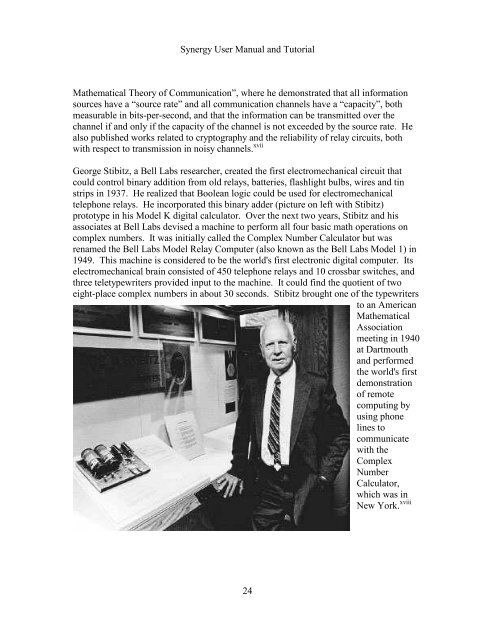Synergy User Manual and Tutorial. - THE CORE MEMORY
Synergy User Manual and Tutorial. - THE CORE MEMORY
Synergy User Manual and Tutorial. - THE CORE MEMORY
You also want an ePaper? Increase the reach of your titles
YUMPU automatically turns print PDFs into web optimized ePapers that Google loves.
<strong>Synergy</strong> <strong>User</strong> <strong>Manual</strong> <strong>and</strong> <strong>Tutorial</strong><br />
Mathematical Theory of Communication”, where he demonstrated that all information<br />
sources have a “source rate” <strong>and</strong> all communication channels have a “capacity”, both<br />
measurable in bits-per-second, <strong>and</strong> that the information can be transmitted over the<br />
channel if <strong>and</strong> only if the capacity of the channel is not exceeded by the source rate. He<br />
also published works related to cryptography <strong>and</strong> the reliability of relay circuits, both<br />
with respect to transmission in noisy channels. xvii<br />
George Stibitz, a Bell Labs researcher, created the first electromechanical circuit that<br />
could control binary addition from old relays, batteries, flashlight bulbs, wires <strong>and</strong> tin<br />
strips in 1937. He realized that Boolean logic could be used for electromechanical<br />
telephone relays. He incorporated this binary adder (picture on left with Stibitz)<br />
prototype in his Model K digital calculator. Over the next two years, Stibitz <strong>and</strong> his<br />
associates at Bell Labs devised a machine to perform all four basic math operations on<br />
complex numbers. It was initially called the Complex Number Calculator but was<br />
renamed the Bell Labs Model Relay Computer (also known as the Bell Labs Model 1) in<br />
1949. This machine is considered to be the world's first electronic digital computer. Its<br />
electromechanical brain consisted of 450 telephone relays <strong>and</strong> 10 crossbar switches, <strong>and</strong><br />
three teletypewriters provided input to the machine. It could find the quotient of two<br />
eight-place complex numbers in about 30 seconds. Stibitz brought one of the typewriters<br />
to an American<br />
Mathematical<br />
Association<br />
meeting in 1940<br />
at Dartmouth<br />
<strong>and</strong> performed<br />
the world's first<br />
demonstration<br />
of remote<br />
computing by<br />
using phone<br />
lines to<br />
communicate<br />
with the<br />
Complex<br />
Number<br />
Calculator,<br />
which was in<br />
New York. xviii<br />
24

















